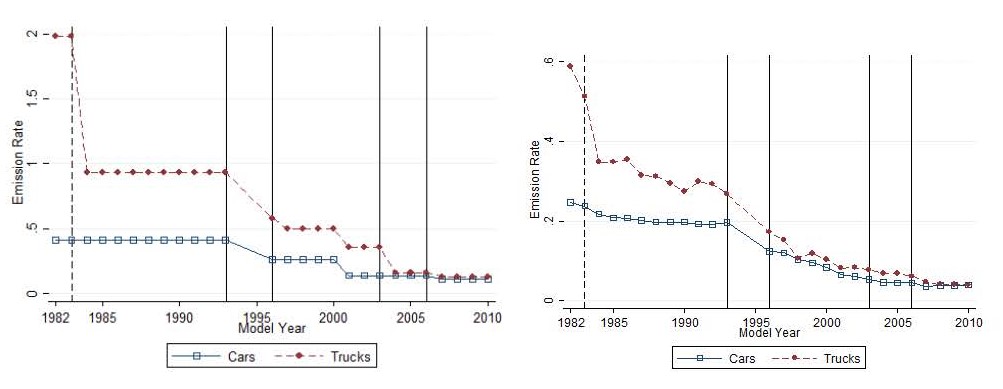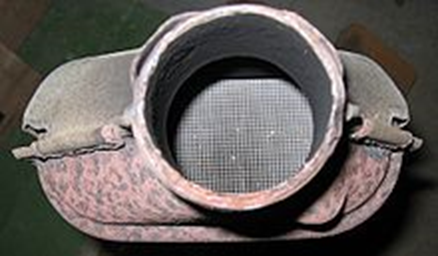Are Vehicle Air Pollution Standards Effective, Efficient, and Equitable?
Co-authored with Mark R. Jacobsen, James M. Sallee, and Arthur A. van Benthem
–
Exhaust standards drove 99% declines in vehicle emissions, but still need scrap incentives for old vehicles.
In the 1960s, vehicle emissions played a big role in urban air pollution. Cities like Los Angeles and New York suffered from paralyzing smog. In the last half century, their air quality improved enormously. How have tighter exhaust standards contributed to these air quality improvements? More broadly, how should governments regulate air pollution from the world’s 1.4 billion passenger vehicles?
Source: https://en.wikipedia.org/wiki/Pollution_in_California
Vehicle Emission Rates Have Declined Rapidly
Our new working paper studies air pollution from US passenger vehicles. We analyze 65 million vehicle pollution readings, including roadside remote sensing readings that are impervious to the kinds of “defeat devices” that accounted for Volkswagen’s recent diesel scandal.
The graph on the left below shows the average emissions rate of a pollutant called volatile organic compounds (if you ever notice yucky smells when pumping gas, this is what you’re smelling) from new US vehicles. This emission rate fell by over 99 percent in the last half century.

Emission rates from new US vehicles—volatile organic compounds (left) and CO2 (right).
In case you didn’t fall off your chair at that statistic, now would be a reasonable time to do so. You read this spectacular 99% decrease correctly. Other local air pollutants like carbon monoxide and nitrogen oxides follow similar trends, and similar trends hold for used vehicles. The graph on the right shows that carbon dioxide (CO2), which is proportional to fuel economy, fell by much less. This may not be surprising since vehicles continue to get heavier and since fuel economy (CAFE) standards have tightened much less than air pollution standards have.
Exhaust Standards Decrease Emission Rates
Our paper shows that policy was the key driver of these reductions. Air pollution exhaust standards, which are the centerpiece of the Clean Air Act’s regulation of transportation, set a maximum emission rate which new vehicles may not exceed. Most countries have adopted versions of such standards (many of which were pioneered in California), including the EU, China, India, Russia, and Brazil. Volkswagen’s “defeat device” cheating on exhaust standards has led analysts to question whether these standards reduce emissions at all. These exhaust standards exist alongside CAFE fuel economy standards.
The graphs below reveal a tight correspondence between exhaust standards (graph on left) and actual emissions (right). Each differs between light-duty vehicles (“cars”) and light-duty trucks (“trucks”: SUVs, pickups, minivans). In 1984, standards became more stringent for trucks but not cars, and emission rates did also. Similar patterns occurred in the 1990s and 2000s. Auto manufacturers actually over-comply with all exhaust standards to minimize the risk of violations, which require costly mass recalls.

Volatile organic compound standards (left) and emissions (right) for new US vehicles.
We analyze alternative potential explanations for the reduction in actual emissions, including fuel economy standards, cleaner (reformulated) gasoline, ethanol blending, and smog check inspections. We conclude that exhaust standards have caused a majority of the decrease in US vehicle emission rates.
How have exhaust standards achieved these gigantic environmental improvements? They use catalytic converters and complementary technologies like oxygen sensors and fuel injection. The precious metals in catalytic converters can in theory eliminate 100 percent of exhaust emissions. Sadly, there is no comparable technology for eliminating CO2 emissions.

Catalytic Convertor. Source: https://en.wikipedia.org/wiki/File:Pot_catalytique_vue_de_la_structure.jpg
Old Vehicles Remain Dirty
So, new vehicles have gotten massively cleaner when they roll out of the showroom. But do they stay clean? A vehicle’s emission rate increases with age and mileage as pollution controls deteriorate. The graph below shows the pollution change for a typical vehicle as it ages, controlling for its odometer rate. Notably, a vehicle’s fuel economy and CO2 emissions rates do not change with vehicle age.
We find that a majority of air pollution emissions come from older vehicles. Exhaust standards only constrain vehicle emissions until 10 or 15 years after the manufacture date. These data come from regions with smog check programs; emissions from older vehicles might have been even greater without smog check. This suggests a role for policy to accelerate retirement of older vehicles, whose pollution costs often exceed the asset value of the vehicle.
Policies Encourage Emissions from Old Vehicles
Unfortunately, existing exhaust standards implicitly encourage preservation of older vehicles, rather than accelerating their retirement. Policies which increase the price of new durable goods can extend the lifetime of dirtier used goods as consumers keep them longer to avoid buying more expensive replacements. This phenomenon, known as the Gruenspecht Effect, is relevant for exhaust standards, appliances, homes, and other energy-consuming durables. Tightening exhaust standards that raise the cost of new vehicles extend the lifetime of older vehicles via this effect.
Tax policies make matters worse. Many state and local governments charge vehicle registration fees and property taxes that vary with vehicle attributes. We collected data on these fees across the US. Our data show that existing registration fees and property taxes are the highest for the youngest and cleanest vehicles. This encourages households to drive older, dirtier used vehicles.
–
Reforming Exhaust Standards and Registration Fees Improves Well-Being but Have Complex Effects on Inequality
We build a model to study how changing exhaust standards or registration fees would affect pollution and well-being. We find that exhaust standards substantially decrease pollution. Tighter exhaust standards in the 2000s, for example, decreased national vehicle emissions by several percent annually. We estimate that these standards produce over ten dollars in environmental benefits for each dollar of compliance costs.
We find even larger benefits from making registration fees increase to reflect older vehicles’ emissions. If drivers paid annual registration fees equal to a vehicle’s environmental damages, vehicle emissions would fall by a third, and drivers would scrap most 20-year-old vehicles.
These reforms, however, have complex effects on inequality. Lower income households drive older and more polluting vehicles. Hence, increasing registration fees for older vehicles would burden these households. Tightening exhaust standards disproportionately increases prices of newer vehicles, which initially affects higher-income households more, and higher-income households also own more vehicles per person. Revenues from higher registration fees could be used for rebates or tax cuts to low income households to make the changes less regressive.
At the same time, transportation pollution is among the biggest air quality problems for low-income communities and communities of color. Decreasing vehicle emissions will provide the largest environmental benefits to these communities.
Real Progress on Vehicle Pollution, but More Work to Do
US vehicle emissions have fallen dramatically in the last half century, largely due to exhaust standards, but older vehicles still account for a large share of emissions. As the US transitions to electric vehicles, tradeoffs between cleaner new vehicles and dirtier old gasoline vehicles may only become more pronounced.
Keep up with Energy Institute blogs, research, and events on Twitter @energyathaas.
Suggested citation: Mark R. Jacobsen, James M. Sallee, Joseph S. Shapiro, and Arthur A. van Benthem. “Are Vehicle Air Pollution Standards Effective and Efficient?” Energy Institute Blog, UC Berkeley, December 5, 2022, https://energyathaas.wordpress.com/2022/12/05/are-vehicle-air-pollution-standards-effective-efficient-and-equitable/
Categories

I assumed emissions standards also included PM10 and PM2.5 but apparently only HC, CO and NOx are regulated? What’s the reasoning for seemingly ignoring PM pollution?
A missing component in this very good paper may be the miles driven annually for older vehicles. We have both a 1995 and a 1996 Honda Odyssey driven 500 and 2,000 miles/year each respectively. These vehicles are only used as backup transport in a four person household with a 2011 electric Leaf (6,000 miles/year local trips only), a 2017 Prius hybrid (20,000 miles a year, used on all long trips), and a 2019 Forester SUV (8,000 miles/year; only purchased for ground clearance and AWD if we have to escape a forest fire over dirt roads from where we live.) The 1995 is basically used as a pickup for hauling trash and construction materials, hence the few miles/year. Both Hondas still pass their smog tests. Their environmental effect should be gauged on the mileage driven and the environmental damage resulting from buying new ones to replace them. It is possible that many of the older vehicles on the road are also driven very low mileage per year, minimizing the effect of their increased emissions. Since on every smog test the mileage of the vehicle is taken, it should be possible to determine the smog production per year from the smog output of the vehicle and the miles driven, and determine the significance of these older vehicles. As far as CO2 production is concerned, the CO2 production of making a replacement vehicle should be taken into account.
We completed a draft report for CARB in 1998 on the economics of implementing a vehicle scrappage program. CARB never approved and issued a final report.
Wouldn’t it make sense from an environmental and equity perspective to get old ICE vehicles off the road by thing EV purchase incentives to one or more of these factors: (1) the age of the internal combustion vehicle being replaced (2) the number of miles it has been driven in the last 2-3 years (3) the income level of the owner? Coltura.org is working to advance legislation built around ideas like these.
Here’s 2 California programs that fit that bill:
https://ww2.arb.ca.gov/sites/default/files/movingca/vehiclescrap.html
https://cleanvehiclegrants.org/
And here’s more on programs that target low income and multi family households:
https://mcubedecon.com/2022/06/14/getting-evs-where-we-need-them-in-multi-family-and-low-income-communities/
A discussion of these programs hitting headwinds: https://calmatters.org/environment/2022/08/california-electric-cars-rebates/